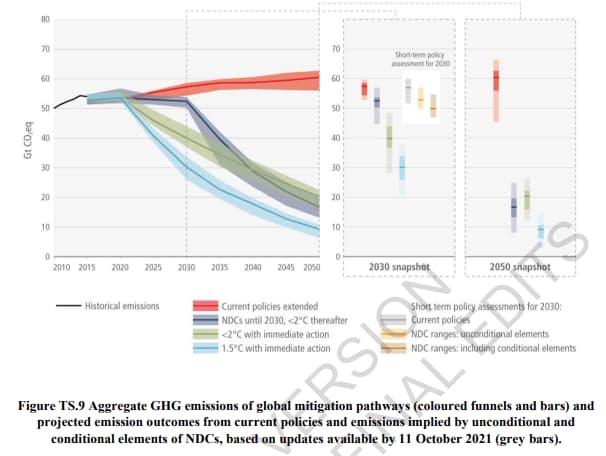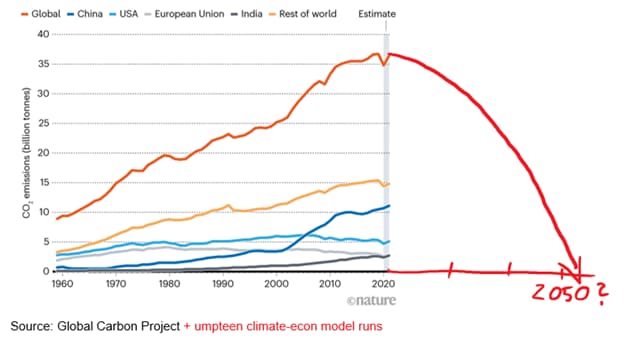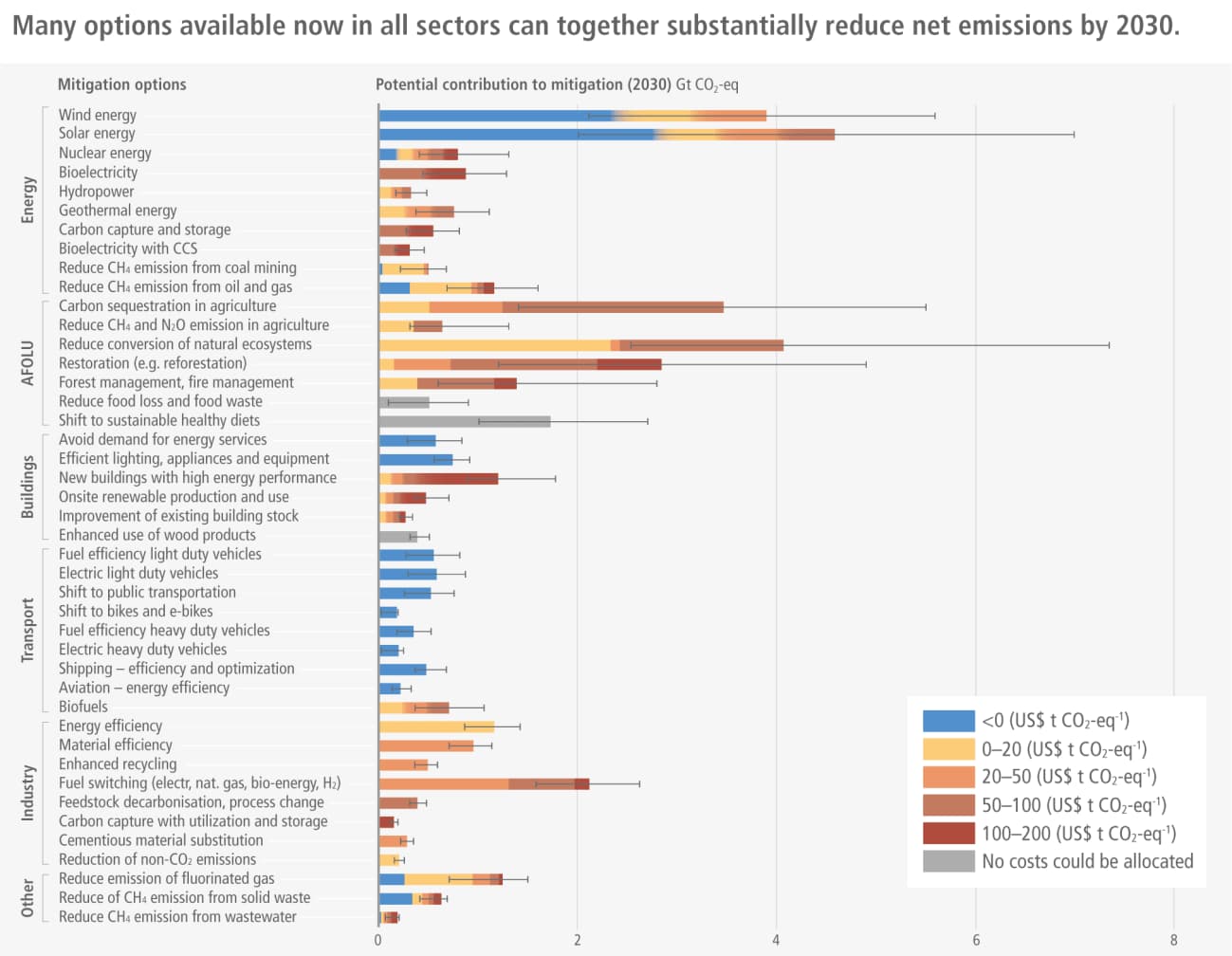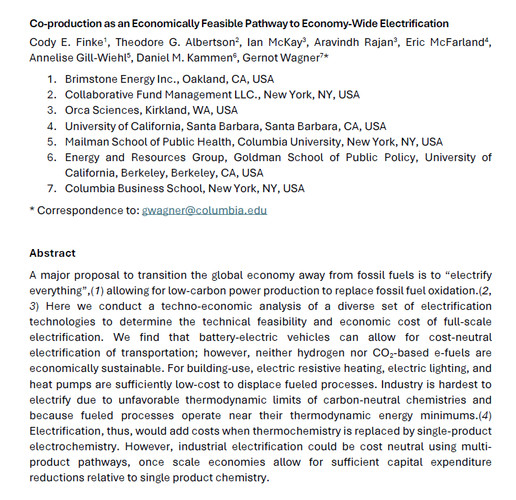It’s late, and it’s cheap
A lot more needs to happen, a lot more can happen
Monday saw the publication of the latest IPCC report. It’s another 2,913 pages. And that’s just the third of three reports in this current go-around, pushing the total assessment to well over 10,000 pages.
I can’t claim I’ve read every page, but I have now studied that latest part focused on mitigation in quite a bit of detail. (And full disclosure: Even though my tweet thread Monday morning after the formal release said I’d focus on highlights “as I read the report,” I had seen drafts of most of the report along the way.)
So what to make of this latest report?
In short, the world isn’t anywhere close to where it needs to be. A lot more needs to happen. A lot more can happen, at much lower costs than often assumed.
The first point seems obvious by now. Current policies (in red) barely stabilize emissions. Country commitments through 2030 (in navy) do a bit better, but barely.

A lot more needs to happen. Full stop.
Perhaps the key point hidden in all of this: it’s worth it. That’s, of course, where climate economics shines, comparing benefits to costs, and the verdict there is clear: spending the money to cut emissions, to near-zero by mid-century, is well worth the costs.
Those umpteen “net-zero” climate goals have a solid scientific and economic foundation.

That’s where the good news kicks in, and that one new killer graph that will stay with us for quite a while: Costs of mitigation are coming down, fast, and are much lower than most think:

A lot of work has gone into getting that graph just so, and it’s a good one. For one, low-carbon energy sources have gotten a lot cheaper over the years, and they’re only going to get cheaper still.
Yes, prices for some precious metals are through the roof, but clean tech innovation isn’t going to stop suddenly. Remember how the financial press was all over European Central Bank Executive Board member Isabel Schnabel ‘coining’ the term “greenflation”? Yes, that potential is surely still there, but she has since spoken forcefully about “fossilflation,” emphasizing how it is fossil fuels that are “to blame for much of the recent strong increase in euro area inflation.”
It would, of course, be a mistake to look at this, conclude that wind and solar are the big blue bars, focus on them, and dismiss everything else. Even the most expensive (dark red) options come in at under $200 per ton of CO2 in this tally, well within reasonable estimates of the social cost of carbon.
Beggars can’t be choosers. We need it all, and then some. The IPCC report has something for everyone, and for everyone’s favorite solution. Listen to those most interested in pushing wind and solar, and they will tell you how the IPCC says that wind and solar are key. (They are.) Listen to those most interested in carbon removal technologies, and you will hear the same. And yes, they, too, are key, and so is everything else.
The one key bit there: the IPCC report does focus quite a bit on “demand-side measures” across sectors, and on systems from energy to food to transport and buildings, among others. Technologies are key, but they alone won’t bail us out. Welcome to the Twitter feed of the Director of AI at Tesla, who goes on a European vacation and discovers how there are better ways to organize society than the sprawling ‘burbs of Silicon Valley.
The fact that the IPCC report has something for everyone makes it at once so important, and also rather maddening. There’s no single quick fix to solve it all. Never was, never will. The report is a massive blueprint for action, with marching orders in lots of different, mutually reinforcing directions. And then, of course, there’s the ever-present politics, and Max Weber’s ever-prescient “slow boring of hard boards.”
Will this report finally cut through the politics and get it all done? No. It’s the sixth assessment, and yes, there will be a seventh, much like there will be another UN climate meeting, and another Senate hearing on the importance of moving that legislation that’s been stuck in committee forever.
Call me jaded, or hopelessly optimistic, but this time does feel different. Yes, Europe is still—six weeks in—sending well over €500 million a day to Putin to help fund his war, while oil & gas companies are once again making a killing. But nobody these days seems to think that’s a-okay. Perhaps it’s the optimism you feel teaching fifty MBAs focused on the solutions, but there are many more minds trying to figure out how to get to net-zero than there are trying to dig in further still.
None of this will happen automatically, and it must happen much faster. But the fact that we’re breezing past deadlines left and right seems obvious to everyone. Every one of these deadlines offer false security based on false precision. This report, for example, shows over and over how global emissions should have peaked a long time ago, and should be well under way toward net-zero. Shoulda, coulda.
The latest deadline making the rounds? This report mentions how global emissions peak “at the latest before 2025” to limit global average warming to 1.5°C (with greater than 50% probability) and 2°C (>67%). Neither probability is reassuring. Still, deadlines have their uses. They focus the mind. The “2025” one? January 1st, 2025 is fewer than a thousand days from today, 999 to be exact.

